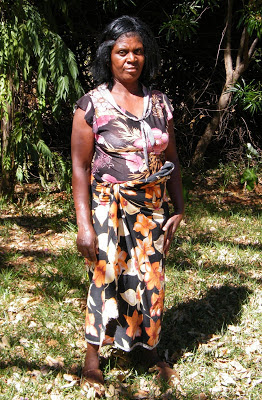From the latest issue of the Zambezi Traveller - available in print and online.
That versatile chitenge
By Clare Mateke
The chitenge is a traditional Zambian garment worn like a skirt wrapped around the waist by women. It is used in many parts of Africa and is known as kitenge in some countries. It plays a major role in African dress but it also has many other uses.
The chitenge is colourful, soft and lightweight and is such a useful item that every Zambian woman owns one and rarely goes anywhere without one. The last time I travelled by bus I carried one of my chitenges and during the six hour journey I used it as a pillow, protection from cold, sunscreen and footrest. I do not know what I would have done without it!
For most purposes the chitenge is a plain, untailored, two metre piece of cloth printed in a bold, bright design. It probably has its origins in the first pieces of cloth that were brought to Africa through inter-continental trade. Prior to this, women’s skirts were made with grass or animal skins. In rural Zambia when a woman comes of age she must start wearing a chitenge as a sign that she is now a woman and must dress respectably. Covering of the legs is considered vital to modest female dress. It is particularly important that a married woman wears a chitenge when visiting her in-laws to show respect. It would be unusual in any Zambian rural village to find a woman not wearing a chitenge, and even in towns it is uncommon. Nowadays they may also be worn over a skirt, trousers or dress.
A chitenge may be used like an apron, protecting one’s clothes when cooking or sweeping. Rolled up on top of the head it is used as cushioning when carrying containers of water or firewood. It is used as a sling to carry babies on the backs of mothers or older female siblings. The chitenge is even used as a purse, by tying up money in a corner of it and then tucking it into the waist. In areas where clean drinking water is scarce villagers may even use their chitenges to filter water. Often a new-born baby is wrapped in a chitenge upon delivery, and when someone dies they may be wrapped in their favourite chitenge to take to the grave.
Print designs include traditional and tribal patterns, as well as a variety of religious and political motifs. Large quantities of political party chitenges are distributed during election times as campaign materials. While the untailored cloth is often used as an inexpensive piece of clothing, it can also be used to make tailored outfits for office-use, conferences and weddings. These are usually two-piece outfits, comprising a top and skirt. They are a post-colonial modification of the traditional wrap, influenced by West African clothing trends.
The tradition of carrying babies in chitenges varies from one country to another. In Zambia the baby is put on the back and the chitenge is brought over the right shoulder and under the left arm then tied across the chest. This tradition is similar in East Africa. However, in other parts of southern and western Africa, the cloth is brought under both arms and tucked under itself above and below the chest.
Read more:
Rich symbolism in Zambia’s heraldry (ZT, Issue 13, June 2013)
Zambia’s national anthem: a history (ZT, Issue 13, June 2013)
That versatile chitenge (ZT, Issue 13, June 2013)
The first newspaper in Zambia (ZT, Issue 13, June 2013)
Did you know you can download a pdf version of the current, and past issues, of the Zambezi Traveller online:
Zambezi Traveller Downloads







No comments:
Post a Comment